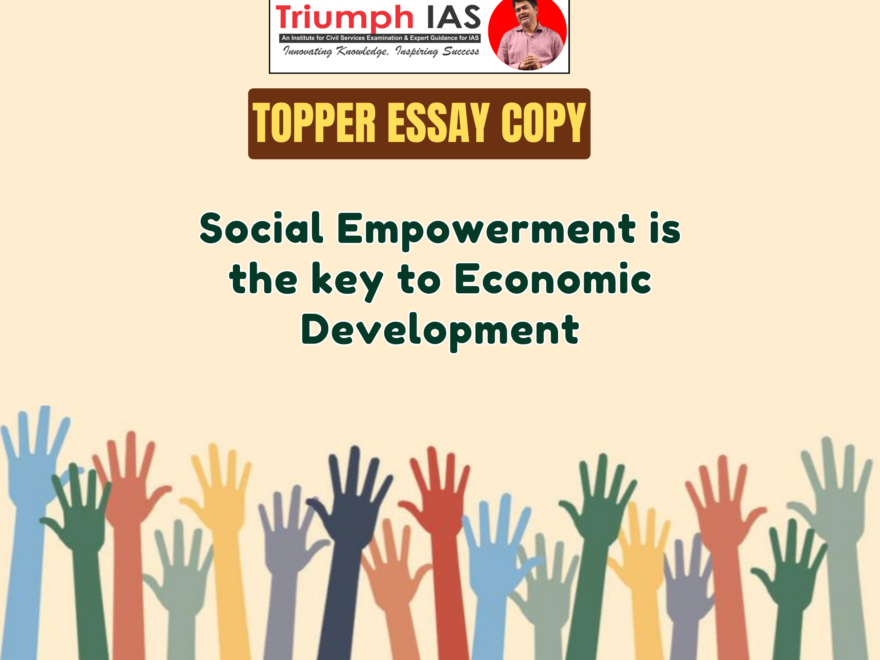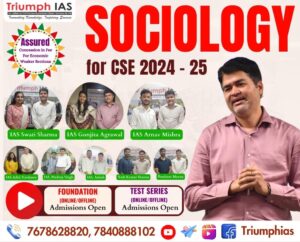IPS, SANKET KUMAR

Essay Topic:
Social Empowerment is the key to Economic Development.
(Relevant for Essay Writing for UPSC Civil Services Examination)
Social Empowerment is the key to Economic DevelopmentBihar government, in 2008-09 initiated SHG named ‘Jeevika’ which mobilized women to join it and take up self-employment opportunities. Since its inception, it has provided loans to many women for starting small employment activities like tailoring, weaving, Dabad-Achaad making. This social empowerment of women has not only brought confidence in themselves but also led to the economic development of their households and of the country. This is just one of the examples of many such inspiring stories that have happened in India in the last few decades. Social empowerment is the empowerment of different sections of society, be it women, SC/STs, farmers, or even regions themselves, by providing them with opportunities and equitable resources to develop. While economic development is the development of the country in its GDP, Human Development Index, standards of life, etc. Undoubtedly, when every section of society is empowered, it pushes economic empowerment as well. But there are various challenges that need to be resolved to enable free flow of channels. Evidence of this fact can be seen historically as well, when Feudalism was dominating European society, where the upper class of society treated the lower class as their subjects, depriving them of their rights, leading to the stagnancy of society. Even the productivity of agriculture, the highest shared economic activity, declined exponentially. In fact, India also witnessed a similar situation in the early medieval times because of land grants to the Brahmankal section. Mini-Republics were developed totally confined to themselves, which led to economic degeneration. Prosperous towns like Pataliputra etc. got deserted. But the advent of the Renaissance in European countries, which talked about modern human rights, equality in society, and social development, pursued the Industrial Revolution. And the rest, as we all know, is how human civilization made a leap from orthodoxy to enlightenment, rationalism, and humanism. Since it is also historically justified that one leads to another. Now we will move to understand in detail. Economic development of a country is not determined by how all its regions are contributing to it. In India’s case, the contribution is highly skewed. Few regions have developed enormously while others are struggling for it. States like Bihar, Uttar Pradesh, Rajasthan, etc. If we try to find what’s common in all these states, then it will be social backwardness. Still, people of these regions are resisting change. Nevertheless, government policies are also responsible for such a skewed trend. Orthodox and conservative traditions and customs have created a hurdle in their path of development. Communalism, casteism, and regionalism are complementing the cause. When we look at the northeastern region, despite enormous potential for economic development due to the presence of natural resources, social backwardness has kept the region undeveloped. Demographic surplus is another social strength of India. The proportion of India’s population in the working age bracket has enormous potential to generate human capital, which can boost economic development significantly. Different countries have utilized this window of opportunity to jump from developing to developed, like South Korea, China, etc. India should also exploit the potential before the window gets closed. FAO reports have stated that if women are provided with the same level of resources that men have access to, then they can increase the GDP growth rate by 2.3%, and per capita income will get enhanced by 20%. But in India, it is very ironical that 48.5% of the population contributes only 17% of employment. Even in agriculture, women can increase the productivity by 10-15%, which is very significant. Scheduled caste and scheduled tribes groups, which are largely excluded from any economic activity and most of their activity is unorganized, can be leveraged to help in augmenting economic development. Traditional economic activities like weaving, embroidery, spinning, and tribal products have significant global and domestic demand. But such sectors have not been assimilated with the mainstream economy. 50% employed in India are involved in agricultural work, contributing only 14% of the output. At the production level, India is a global leader in various crops, fruits, vegetables, meats, and dairy. But when it comes to productivity level, our performance drops down to the lowest ones. Undoubtedly, the potential is there but has not been tapped properly. 8.3 million units of MSMEs contribute around 37% of GDP. Although they have immense potential to contribute towards the growth of the country, mighty informatized, obsolete technologies, lack of adequate skill, and market connectivity have inhibited them from realizing it. Various challenges have acted as a bottleneck for letting social empowerment contribute towards economic development. ‘Patriarchy’ which forces women to stay behind doors is very much responsible for such a situation of women. Further, sexual harassment at the workplace, stereotyping women with household and family work, lack of educational attainment, and mechanization of agriculture have also contributed equally towards this grievous situation. Social exclusion, erosion of the traditional economy due to government negligence, poor health & educational facilities have contributed towards the cause of SC/ST’s backwardness. Lack of marketing opportunities for tribal products and also connectivity with markets is not letting them connect with the mainstream economy. For farmers, absence of forward and backward linkages, poor penetration of APMC mandis, frequent distress sale, failure of Government’s MSP policy, digital divide, and financial exclusion have stopped their social empowerment. Another section of the society is the ‘Divyang’ disabled group. They face marginalization due to the absence of adequate infrastructure facilities at public places, lack of self-confidence, and absence of work-from-home facilities, which is not letting them contribute towards economic development. Last but not least, poverty is the grievous social evil, which has kept many in a ‘vicious cycle’. This trap is not letting them escape and contribute to economic development through ‘saving’ and augmenting consumption demand. Thus, the need of the hour is to empower all these social groups such that this will trickle down to economic development. For this, the government has to focus initially on the penetration of education and health facilities to the deepest part of the country. Upgradation of existing ones and opening up new ones is the need of the moment. In fact, the government should increase the percentage of GDP expenditure to these sectors in a phased manner to 6%. Skill development programs in underdeveloped areas should be provided. This can be done in collaboration with industries so that need-based training could be provided. By focusing on ‘women-led development’ by enacting schemes for the feminization of agriculture, providing credit to women members of the family by mobilizing them in SHGs, providing safe and secure environments at the workplace, and encouraging them and their families to let her take higher education. For tribals, providing them a platform to showcase their products and sell them. But all of this should be done by assuring them for the preservation of their culture, traditions & customs. Reservation in employment and educational instructions should be streamlined such that the needy should get benefit. Opening of Micro Finance institutions, and along with encouragement for online banking can improve financial inclusion and will help both farmers and those involved in small-scale industries. The government has taken various initiatives in this regard like Sarva Shiksha Abhiyan, Lastinba Valika Vidyalaya, PM Jan Arogya Yojana for Education & Health respectively. PM Kaushal Vikas Yojana for skill development. Sexual Harassment at the workplace Act for providing safety to women. USTAAD, TRIFOOD, Adi Mahotsav to incentivize and brandize tribal products. Jan Dhan Yojana, Mudra Yojana, etc., for MSMEs and Farmer’s financial Inclusion. But still, the journey is long. In order to attain economic development through social empowerment. Our efforts should be based on ‘Sabka Saath Sabka Vikaas Sabka Vishwas’. |
To master these intricacies and fare well in the Sociology Optional Syllabus, aspiring sociologists might benefit from guidance by the Best Sociology Optional Teacher and participation in the Best Sociology Optional Coaching. These avenues provide comprehensive assistance, ensuring a solid understanding of sociology’s diverse methodologies and techniques
Meta Tags:
Urbanisation, Blessing, Disguise, Economic Growth, Cultural Diversity, Environmental Challenges, India, Social Inclusion, Sustainable Development, SDG Goals, Urbanization is a blessing in disguise, Laxman Tiwari, Laxman Tiwari upsc, Laxman Tiwari CSE, Laxman Tiwari Essay copy, Laxman Tiwari Essay test copy

Why Vikash Ranjan’s foundation Classes for Essay?
Proper guidance and assistance are required to learn the skill of writing essay topics in CSE examination. VIKASH RANJAN SIR at TRIUMPH IAS guides students according to the Recent Trends of UPSC, making him the Best Essay Teacher for Essay writing UPSC.
At Triumph IAS, the Best Essay Writing Coaching platform, we not only provide the best study material and applied classes of Essay for IAS but also conduct regular assignments and class tests to assess candidates’ writing skills and understanding of the subject.
Choose The Best Essay Writing Teacher for IAS Preparation and Know our Approach for Essay?
- The Programme is Planned & Executed in a Way that You Write a good Essay for obtaining Effective Score of 140 Plus.
- In this programme we provide Classes on
- How to INTRODUCE The Topic in Context of the THEME of the Essay
- How to Elaborate & Explain the Topic-Theme on Temporal Scale & Sectoral Scale as well as Intellectual Scale in the MAIN BODY of the Essay.
- How to Sum up the Topic in CONCLUSION in Context of the Essay Topic Theme.
- ︎We will Teach You How to use the Knowledge Matrix of General Studies & Optional to write a Good Essay more Logically and Coherently.
- After the Classes You have to “Write to Learn & Learn to Score” .This means You have to Write the Essay Test Papers & Learn from the Feedback & Discussions.
Why Essay is Important and What We Offer in “Essay Test Series”?
- Triumph’s Essay Upgradation Test Series (Under Personal Guidance of Vikash Ranjan Sir) doesn’t only focus on improving student’s linguistic skills but also focus on improving student’s ability to comprehend the topic-sentence (subject) recall & relate the facts, concepts, propose thesis-statements, and logically assimilate the ideas & counter ideas with clarity in expression on temporal & Sectoral Scales of knowledge.
- Further students are provided one-on-one INTERACTION* Session with Vikash Ranjan Sir. Students get personal feedback on their strength and weaknesses, regarding what is ‘good about their essay and what more should be done to make it a better one’ by Vikash Ranjan Sir.
Why to take up this “Essay Test Series and Foundation” Course?
- Essay is Low hanging Fruit. Marks in Essay is Effectively Contributing in Final Selection in New Pattern of Mains Exam. With a Well Developed ‘Knowledge Matrix and Rigorous Practice’, One can Score upto 160 + in Essay. So IAS Aspirants should never Ignore Essay Preparation
- Inculcating Writing Competency in Essay for IAS, which is Different from Essay in English, Essay in School and College.
Follow us :
🔎 https://www.instagram.com/triumphias
🔎https://www.youtube.com/c/TriumphIAS
🔎https://t.me/VikashRanjanSociology
Find More Blogs…
| Compare and contrast Karl Marx’s and Max weber’s | Karl Marx- Historical Materialism |
| Position of Women In the Modern Indian Society | Sociology: Social system and pattern variables |
keyword: Social Empowerment is the key to Economic Development , Social Empowerment is the key to Economic Development , Social Empowerment is the key to Economic Development , Social Empowerment is the key to Economic Development , Social Empowerment is the key to Economic Development , Social Empowerment is the key to Economic Development , Social Empowerment is the key to Economic Development , Social Empowerment is the key to Economic Development , Social Empowerment is the key to Economic Development , Social Empowerment is the key to Economic Development , Social Empowerment is the key to Economic Development , Social Empowerment is the key to Economic Development , Social Empowerment is the key to Economic Development , Social Empowerment is the key to Economic Development , Social Empowerment is the key to Economic Development , Social Empowerment is the key to Economic Development , Social Empowerment is the key to Economic Development ,


